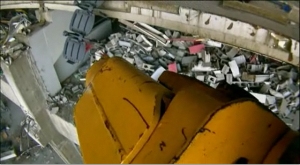Shooting a 3D documentary: wiring a ContourHD POV system
One of the issues we ran into while getting ready to shoot our first 3D documentary was controlling our POV cams on without knocking them out of alignment.
We chose two ContourHDs to capture POV footage on this shoot – the implosion of the Fonte Nova Stadium in Salvador, Brazil for the explosive demolition series Blowdown – over the two GoPro HDs because the ContourHD’s shape (round) allows for a smaller interaxial distance than the GoPro HD’s (boxy).
The ContourHD’s lasers also allow the crew to confirm the cameras are aligned horizontally after they’re placed on our custom-made aluminum side by side rig and before they’re mounted on a Magic Arm or tripod.
The one problem with these cameras is that the switches are big and cumbersome – our stereographer, Sean White, was concerned about knocking the cameras out of alignment when it’s time to record.
So we’ve had a single switch hardwired into both camera’s circuitry.
Now we can turn both on at the same time without having to worry about alignment issues.
Sean with the wired ContourHD POV system, and some other 3D gear:
VIDEO


